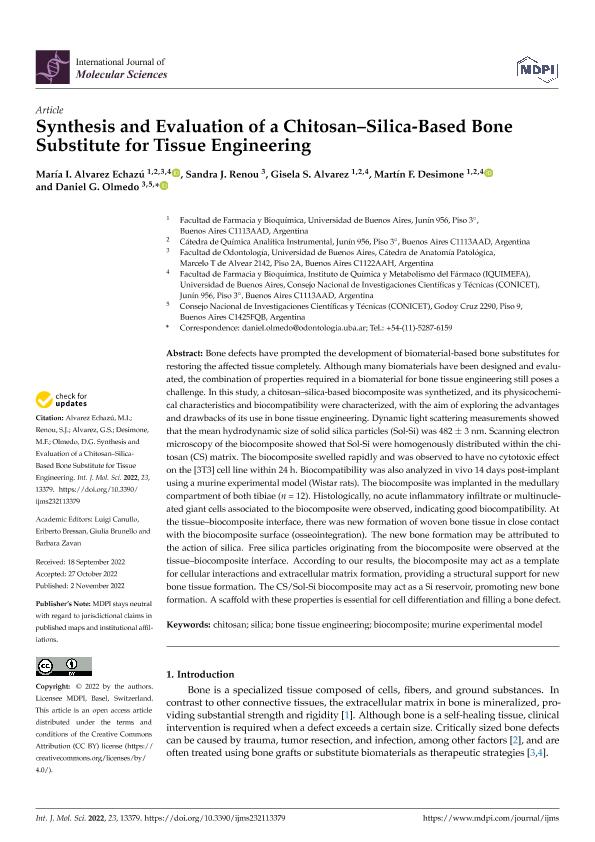Mostrar el registro sencillo del ítem
dc.contributor.author
Alvarez Echazú, María Inés

dc.contributor.author
Renou, Sandra Judith

dc.contributor.author
Alvarez, Gisela Solange

dc.contributor.author
Desimone, Martín Federico

dc.contributor.author
Olmedo, Daniel Gustavo

dc.date.available
2023-09-04T17:34:22Z
dc.date.issued
2022-11
dc.identifier.citation
Alvarez Echazú, María Inés; Renou, Sandra Judith; Alvarez, Gisela Solange; Desimone, Martín Federico; Olmedo, Daniel Gustavo; Synthesis and Evaluation of a Chitosan–Silica-Based Bone Substitute for Tissue Engineering; Molecular Diversity Preservation International; International Journal of Molecular Sciences; 23; 21; 11-2022; 1-19
dc.identifier.issn
1422-0067
dc.identifier.uri
http://hdl.handle.net/11336/210417
dc.description.abstract
Bone defects have prompted the development of biomaterial-based bone substitutes for restoring the affected tissue completely. Although many biomaterials have been designed and evaluated, the combination of properties required in a biomaterial for bone tissue engineering still poses a challenge. In this study, a chitosan–silica-based biocomposite was synthetized, and its physicochemical characteristics and biocompatibility were characterized, with the aim of exploring the advantages and drawbacks of its use in bone tissue engineering. Dynamic light scattering measurements showed that the mean hydrodynamic size of solid silica particles (Sol-Si) was 482 ± 3 nm. Scanning electron microscopy of the biocomposite showed that Sol-Si were homogenously distributed within the chitosan (CS) matrix. The biocomposite swelled rapidly and was observed to have no cytotoxic effect on the [3T3] cell line within 24 h. Biocompatibility was also analyzed in vivo 14 days post-implant using a murine experimental model (Wistar rats). The biocomposite was implanted in the medullary compartment of both tibiae (n = 12). Histologically, no acute inflammatory infiltrate or multinucleated giant cells associated to the biocomposite were observed, indicating good biocompatibility. At the tissue–biocomposite interface, there was new formation of woven bone tissue in close contact with the biocomposite surface (osseointegration). The new bone formation may be attributed to the action of silica. Free silica particles originating from the biocomposite were observed at the tissue–biocomposite interface. According to our results, the biocomposite may act as a template for cellular interactions and extracellular matrix formation, providing a structural support for new bone tissue formation. The CS/Sol-Si biocomposite may act as a Si reservoir, promoting new bone formation. A scaffold with these properties is essential for cell differentiation and filling a bone defect.
dc.format
application/pdf
dc.language.iso
eng
dc.publisher
Molecular Diversity Preservation International

dc.rights
info:eu-repo/semantics/openAccess
dc.rights.uri
https://creativecommons.org/licenses/by/2.5/ar/
dc.rights.uri
https://creativecommons.org/licenses/by/2.5/ar/
dc.subject
BIOCOMPOSITE
dc.subject
BONE TISSUE ENGINEERING
dc.subject
CHITOSAN
dc.subject
MURINE EXPERIMENTAL MODEL
dc.subject
SILICA
dc.subject.classification
Nano-materiales

dc.subject.classification
Nanotecnología

dc.subject.classification
INGENIERÍAS Y TECNOLOGÍAS

dc.title
Synthesis and Evaluation of a Chitosan–Silica-Based Bone Substitute for Tissue Engineering
dc.type
info:eu-repo/semantics/article
dc.type
info:ar-repo/semantics/artículo
dc.type
info:eu-repo/semantics/publishedVersion
dc.date.updated
2023-07-07T22:54:53Z
dc.journal.volume
23
dc.journal.number
21
dc.journal.pagination
1-19
dc.journal.pais
Suiza

dc.journal.ciudad
Basel
dc.description.fil
Fil: Alvarez Echazú, María Inés. Consejo Nacional de Investigaciones Científicas y Técnicas. Oficina de Coordinación Administrativa Houssay. Instituto de Química y Metabolismo del Fármaco. Universidad de Buenos Aires. Facultad de Farmacia y Bioquímica. Instituto de Química y Metabolismo del Fármaco; Argentina
dc.description.fil
Fil: Renou, Sandra Judith. Universidad de Buenos Aires. Facultad de Odontología; Argentina
dc.description.fil
Fil: Alvarez, Gisela Solange. Consejo Nacional de Investigaciones Científicas y Técnicas. Oficina de Coordinación Administrativa Houssay. Instituto de Química y Metabolismo del Fármaco. Universidad de Buenos Aires. Facultad de Farmacia y Bioquímica. Instituto de Química y Metabolismo del Fármaco; Argentina
dc.description.fil
Fil: Desimone, Martín Federico. Consejo Nacional de Investigaciones Científicas y Técnicas. Oficina de Coordinación Administrativa Houssay. Instituto de Química y Metabolismo del Fármaco. Universidad de Buenos Aires. Facultad de Farmacia y Bioquímica. Instituto de Química y Metabolismo del Fármaco; Argentina
dc.description.fil
Fil: Olmedo, Daniel Gustavo. Consejo Nacional de Investigaciones Científicas y Técnicas. Oficina de Coordinación Administrativa Houssay. Instituto de Química y Metabolismo del Fármaco. Universidad de Buenos Aires. Facultad de Farmacia y Bioquímica. Instituto de Química y Metabolismo del Fármaco; Argentina
dc.journal.title
International Journal of Molecular Sciences

dc.relation.alternativeid
info:eu-repo/semantics/altIdentifier/url/https://www.mdpi.com/1422-0067/23/21/13379/htm
dc.relation.alternativeid
info:eu-repo/semantics/altIdentifier/doi/http://dx.doi.org/10.3390/ijms232113379
Archivos asociados
